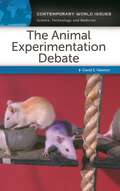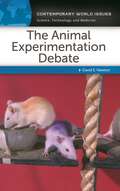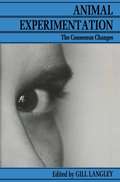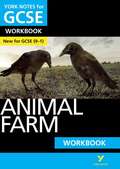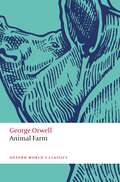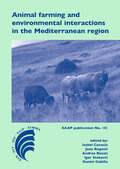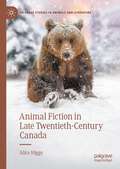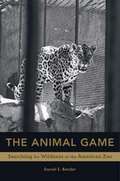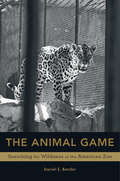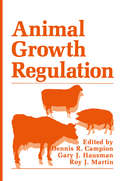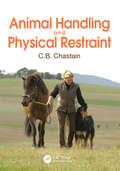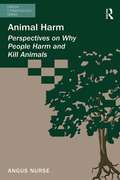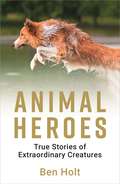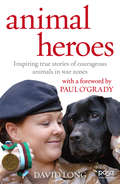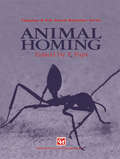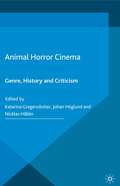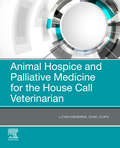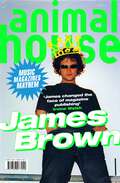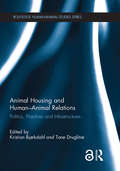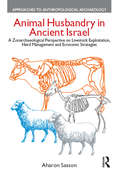- Table View
- List View
Animal Evolution: Genomes, Fossils, and Trees
by NATURAL SCIENCES and MATHEMATICS (500) ZOOLOGICAL SCIENCES (590)Animal life, now and over the past half billion years, is incredibly diverse. Describing and understanding the evolution of this diversity of body plans - from vertebrates such as humans and fish to the numerous invertebrate groups including sponges, insects, molluscs, and the many groups of worms - is a major goal of evolutionary biology. In this book, a group of leading researchers adopt a modern, integrated approach to describe how current molecular genetic techniques and disciplines as diverse as palaeontology, embryology, and genomics have been combined, resulting in a dramatic renaissance in the study of animal evolution. The last decade has seen growing interest in evolutionary biology fuelled by a wealth of data from molecular biology. Modern phylogenies integrating evidence from molecules, embryological data, and morphology of living and fossil taxa provide a wide consensus of the major branching patterns of the tree of life; moreover, the links between phenotype and genotype are increasingly well understood. This has resulted in a reliable tree of relationships that has been widely accepted and has spawned numerous new and exciting questions that require a reassessment of the origins and radiation of animal life. The focus of this volume is at the level of major animal groups, the morphological innovations that define them, and the mechanisms of change to their embryology that have resulted in their evolution. Current research themes and future prospects are highlighted including phylogeny reconstruction, comparative developmental biology, the value of different sources of data and the importance of fossils, homology assessment, character evolution, phylogeny of major groups of animals, and genome evolution. These topics are integrated in the light of a 'new animal phylogeny', to provide fresh insights into the patterns and processes of animal evolution. Animal Evolution provides a timely and comprehensive statement of progress in the field for academic researchers requiring an authoritative, balanced and up-to-date overview of the topic. It is also intended for both upper level undergraduate and graduate students taking courses in animal evolution, molecular phylogenetics, evo-devo, comparative genomics and associated disciplines.
Animal Evolution: Genomes, Fossils, and Trees
by Maximilian J. Telford D. T. J. LittlewoodAnimal life, now and over the past half billion years, is incredibly diverse. Describing and understanding the evolution of this diversity of body plans - from vertebrates such as humans and fish to the numerous invertebrate groups including sponges, insects, molluscs, and the many groups of worms - is a major goal of evolutionary biology. In this book, a group of leading researchers adopt a modern, integrated approach to describe how current molecular genetic techniques and disciplines as diverse as palaeontology, embryology, and genomics have been combined, resulting in a dramatic renaissance in the study of animal evolution. The last decade has seen growing interest in evolutionary biology fuelled by a wealth of data from molecular biology. Modern phylogenies integrating evidence from molecules, embryological data, and morphology of living and fossil taxa provide a wide consensus of the major branching patterns of the tree of life; moreover, the links between phenotype and genotype are increasingly well understood. This has resulted in a reliable tree of relationships that has been widely accepted and has spawned numerous new and exciting questions that require a reassessment of the origins and radiation of animal life. The focus of this volume is at the level of major animal groups, the morphological innovations that define them, and the mechanisms of change to their embryology that have resulted in their evolution. Current research themes and future prospects are highlighted including phylogeny reconstruction, comparative developmental biology, the value of different sources of data and the importance of fossils, homology assessment, character evolution, phylogeny of major groups of animals, and genome evolution. These topics are integrated in the light of a 'new animal phylogeny', to provide fresh insights into the patterns and processes of animal evolution. Animal Evolution provides a timely and comprehensive statement of progress in the field for academic researchers requiring an authoritative, balanced and up-to-date overview of the topic. It is also intended for both upper level undergraduate and graduate students taking courses in animal evolution, molecular phylogenetics, evo-devo, comparative genomics and associated disciplines.
The Animal Experimentation Debate: A Reference Handbook (Contemporary World Issues)
by David E. NewtonReviewing the topic from antiquity to the present day, this book examines the debate over the use of animals in research in a fair and balanced way.The debate over the use of nonhuman animals in experimental research has gone on for centuries, and it continues as vigorously today as it ever has. In fact, in the last decade, the controversy has intensified, making animal testing a topic at the highest level of debate of any socioscientific issue in the United States. This book presents all sides of the issue so that readers can come to their own conclusions as to the morality and validity of animal experimentation, and provides biographies of individuals and descriptions of organizations that have been involved in the debate over the centuries. Additionally, it documents the historical shift in thinking that made animal experimentation commonplace between the time of the ancient Greeks and the 19th century, to the mindset of some who argue for an end to the practice and alternative ways of conducting medical experimentation to benefit human health.
The Animal Experimentation Debate: A Reference Handbook (Contemporary World Issues)
by David E. NewtonReviewing the topic from antiquity to the present day, this book examines the debate over the use of animals in research in a fair and balanced way.The debate over the use of nonhuman animals in experimental research has gone on for centuries, and it continues as vigorously today as it ever has. In fact, in the last decade, the controversy has intensified, making animal testing a topic at the highest level of debate of any socioscientific issue in the United States. This book presents all sides of the issue so that readers can come to their own conclusions as to the morality and validity of animal experimentation, and provides biographies of individuals and descriptions of organizations that have been involved in the debate over the centuries. Additionally, it documents the historical shift in thinking that made animal experimentation commonplace between the time of the ancient Greeks and the 19th century, to the mindset of some who argue for an end to the practice and alternative ways of conducting medical experimentation to benefit human health.
Animal Farm: York Notes For Gcse Workbook Grades 9-1
by David GrantLearn: Tasks and answers on every area of the text to enhance your students' learning and take revision further. Practise: Exercises on spelling, punctuation and grammar, and longer exam-style questions with sample response extracts to practise and perfect key skills for writing top quality answers. Test: Support independent learning and motivate students with quick tests and regular self-assessment to stay on track for success.
Animal farming and environmental interactions in the Mediterranean region (European Association for Animal Production #131)
by I. Casasús, J. Rogošiç, A. Rosati, I. Štokoviç and D. GabiñaLivestock production systems are the result of an interaction between domestic animals and the environment, modulated by man, that dates back to Neolithic times. As a consequence of this interaction among the wide diversity of animal resources, natural habitats and population needs, very different farming systems have developed across the Mediterranean Basin. Understanding the mechanisms and effects of these relationships is key to design the farming systems best adapted to each condition, guaranteeing an adequate balance between target animal production and environmental outcomes provided by these systems. This is indeed a multidimensional topic, influenced by animal genetics, feeding resources, flock management, and economic and social aspects inside and outside the household. Therefore, this book focuses on the basis of the animal-environment interactions and the impact of human activities on the type and magnitude of these interactions. In this context, the issue of sustainability of livestock production is evaluated considering economic, social and environmental aspects. This book contributes to upgrade the state of the art in Mediterranean conditions, providing indicators and procedures of application across a wide range of systems, and hence of interest for researchers, students and professionals concerned with livestock production and the environment.
Animal Fiction in Late Twentieth-Century Canada (Palgrave Studies in Animals and Literature)
by Alice HiggsAnimal Fiction in Late Twentieth-Century Canada fulfils a vital contribution to the conversation surrounding animal representation as a point of continuity in national narratives and supports the idea that focusing on narratives of responsibility and care influences better relations with both non-human animals and across settler-Indigenous boundaries. Alice Higgs engages with on-going debates regarding reconciliation by demonstrating that it is imperative to critique settler colonial environmental frameworks and place autonomy back into Indigenous communities by bringing Indigenous practices of custodianship and relationality to bear more generally. This book also develops a number of conversations in animal studies in relation to the politics of representation. Higgs studies a range of canonical Canadian authors, demonstrating a progress across the period in which it is possible to identify the emergence of a literary pro-animal turn.
The Animal Game: Searching For Wildness At The American Zoo
by Daniel E. BenderTracing the global trade and trafficking in animals that supplied U.S. zoos, Daniel Bender shows how Americans learned to view faraway places through the lens of exotic creatures on display. He recounts the public’s conflicted relationship with zoos, decried as prisons by activists even as they remain popular centers of education and preservation.
The Animal Game: Searching For Wildness At The American Zoo
by Daniel E. BenderTracing the global trade and trafficking in animals that supplied U.S. zoos, Daniel Bender shows how Americans learned to view faraway places through the lens of exotic creatures on display. He recounts the public’s conflicted relationship with zoos, decried as prisons by activists even as they remain popular centers of education and preservation.
Animal Growth Regulation
by D. R. Campion G. J. Hausman R. J. MartinThe biotechnological advances of recent years have put us on the brink of unprecedented gains in animal productivity. Manipulation of animal growth rate and composition of gain is now possible by a variety of techniques. Ex amples include ingestion of beta-adrenergic agonists, injection of somatotropin, castration, immunization, and gene insertion. Animal Growth Regulation ad dresses modem concepts of growth regulation with an emphasis on agricul turally important animals. This emphasis is not exclusive, as many situations exist in which the only information available was generated in other species, and this information has been included for the sake of clarity and completeness. However, because of the overall orientation of this volume, particular attention has been given to the regulation of skeletal muscle, adipose tissue, and bone growth. Certain hormones and growth factors have a profound influence on growth regulation and this basic physiological knowledge is being harnessed to maniplilate growth. Thus, considerable emphasis has been given to growth hor mone-somatomedinlinsulinlike growth factor regulation of cell and tissue growth. The involvement of peptides coded by protooncogenes and of negative growth regulators, such as transforming growth factor-l3, represents an emerging area of molecular biology wherein basic knowledge offers potential exploitation for growth manipulation. Opportunities also exist for regulation of protein turn over, especially from the standpoint of protein degradation. Therefore, a place was reserved for these topics in order to provide relevant basic knowledge.
Animal Handling and Physical Restraint
by C. B. ChastainKey features: Stresses safety in handling, restraint, and containment of animals Covers handling and restraint of all domestic and common tamed animals and provides information on normal animal behavior and welfare Discusses how to recognize signs in animals of poor handling and containment Reviews zoonotic disease risks to animal handlers, particularly from normal-appearing animals, and how to avoid transmission of disease Features over 200 informative line drawings for clarity and simplicity of illustration Explains how to tie useful knots and hitches and when to use them for restraint Includes basic ethical considerations and legal liabilities of animal handling and containment Presents steps to prevent animal escapes, barn fires, and problems with transport Authored by an experienced veterinary educator in clinical medicine for veterinarians, veterinary students, pre-veterinary students, veterinary technicians and technologists, animal scientists, and animal owners Proper handling and restraint are essential to the welfare of captive animals, allowing them to be examined, groomed and treated in ways that contribute to their optimum quantity and quality of life. The aim of the book is to prepare future or current veterinarians and veterinary technologists, technicians/nurses, and assistants to be able to handle animals more safely and gain the confidence of animals and their owners. In turn, they will be able to instruct owners in proper animal handling methods, reducing the risk of physical injury or mutual infectious diseases. Throughout the book, the author emphasises that each animal is an individual and each handling environment provides its own advantages and disadvantages: handling an animal safely, humanely and efficiently requires practical knowledge of the species’ normal behaviour. This is explored in detail in each of the species-based chapters, which cover proper handling of domestic household and laboratory animals, as well as farm and ranch animals where safe handling aids the producer in both humane practice and greater profitability. After reading this book, the practitioner or student will be versed in the most basic part of the art of veterinary medicine: the safe handling of animals.
Animal Handling and Physical Restraint
by C. B. ChastainKey features: Stresses safety in handling, restraint, and containment of animals Covers handling and restraint of all domestic and common tamed animals and provides information on normal animal behavior and welfare Discusses how to recognize signs in animals of poor handling and containment Reviews zoonotic disease risks to animal handlers, particularly from normal-appearing animals, and how to avoid transmission of disease Features over 200 informative line drawings for clarity and simplicity of illustration Explains how to tie useful knots and hitches and when to use them for restraint Includes basic ethical considerations and legal liabilities of animal handling and containment Presents steps to prevent animal escapes, barn fires, and problems with transport Authored by an experienced veterinary educator in clinical medicine for veterinarians, veterinary students, pre-veterinary students, veterinary technicians and technologists, animal scientists, and animal owners Proper handling and restraint are essential to the welfare of captive animals, allowing them to be examined, groomed and treated in ways that contribute to their optimum quantity and quality of life. The aim of the book is to prepare future or current veterinarians and veterinary technologists, technicians/nurses, and assistants to be able to handle animals more safely and gain the confidence of animals and their owners. In turn, they will be able to instruct owners in proper animal handling methods, reducing the risk of physical injury or mutual infectious diseases. Throughout the book, the author emphasises that each animal is an individual and each handling environment provides its own advantages and disadvantages: handling an animal safely, humanely and efficiently requires practical knowledge of the species’ normal behaviour. This is explored in detail in each of the species-based chapters, which cover proper handling of domestic household and laboratory animals, as well as farm and ranch animals where safe handling aids the producer in both humane practice and greater profitability. After reading this book, the practitioner or student will be versed in the most basic part of the art of veterinary medicine: the safe handling of animals.
Animal Harm: Perspectives on Why People Harm and Kill Animals
by Angus NurseWhy do people harm, injure, torture and kill animals? This book evaluates the reasons why these crimes are committed and outlines the characteristics of the animal offender. It considers ethical and value judgements made about animals and the tacit acknowledgement and justification of unacceptable criminal behaviour towards the harming of animals made by offenders. Situating animal abuse, wildlife crime, illegal wildlife trading and other unlawful activities directed at animals firmly within Green Criminology, the book contends that this is a distinct, multi-dimensional type of criminality which persists despite the introduction of relevant legislation. Taking a broad approach, the book considers the killing and harming of animals in an international context and examines the effectiveness of current legislation, policy and sentencing. Including a section on further reading and useful organizations, this book is a valuable exploration into perspectives on the responsibility owed by man to animals as part of broader ecological and legal concerns. It will interest criminologists, ecologists, animal protectionists and those interested in law and society and law and the environment.
Animal Harm: Perspectives on Why People Harm and Kill Animals
by Angus NurseWhy do people harm, injure, torture and kill animals? This book evaluates the reasons why these crimes are committed and outlines the characteristics of the animal offender. It considers ethical and value judgements made about animals and the tacit acknowledgement and justification of unacceptable criminal behaviour towards the harming of animals made by offenders. Situating animal abuse, wildlife crime, illegal wildlife trading and other unlawful activities directed at animals firmly within Green Criminology, the book contends that this is a distinct, multi-dimensional type of criminality which persists despite the introduction of relevant legislation. Taking a broad approach, the book considers the killing and harming of animals in an international context and examines the effectiveness of current legislation, policy and sentencing. Including a section on further reading and useful organizations, this book is a valuable exploration into perspectives on the responsibility owed by man to animals as part of broader ecological and legal concerns. It will interest criminologists, ecologists, animal protectionists and those interested in law and society and law and the environment.
Animal Heroes: True Stories of Extraordinary Creatures
by Ben HoltAnimal Heroes contains some of the most extraordinary true tales of bravery across the natural world, from domestic pets to wild animals, proving that when it comes to facing danger there’s more to them than meets the eye.
Animal Heroes: Inspiring true stories of courageous animals
by David LongThe PDSA Dickin Medal (regarded as the animals’ Victoria Cross) has been awarded to just 64 animals, from the Blitz to present day, for their courage in times of crisis. Among these incredible true-life stories you will meet…G.I. Joe the plucky pigeon, who rescued over 100 lives by flying twenty miles in twenty minutes to deliver a message in World War II.Theo the steadfast springer spaniel, who served as a bomb-detection dog in Afghanistan.Rip the trusty mongrel, who saved many victims of the Blitz air-raids.Olga the courageous police horse, who bolted from the path of a flying bomb in World War II only to return to the scene and remain on duty.These heart-warming tales of gallantry and devotion will stay with you long after you turn the pages.Previously published as The Animals' VC.
Animal Homing (Chapman & Hall Animal Behaviour Series)
by F. PapiHoming phenomena must be considered an important aspect of animal behaviour on account of their frequent occurrence, their survival value, and the variety of the mechanisms involved. Many species regularly rely on their ability to home or reach other familiar sites, but how they manage to do this is often uncertain. In many cases the goal is attained in the absence of any sensory contact, by mechanisms of indirect orientation whose complexity and sophistication have for a long time challenged the skill and patience of many researchers. A series of problems of increasing difficulty have to be overcome; researchers have to discover the nature of orienting cues, the sensory windows involved, the role of inherited and acquired information, and, eventually, how the central mechanisms process information and control motory responses. Naturally, this book emphasizes targets achieved rather than areas unexplored and mysteries unsolved. Even so, the reader will quickly realize that our knowledge of phenomena and mechanisms has progressed to different degrees in different animal groups, ranging from the mere description of homing behaviour to a satisfactory insight into some underlying mechanisms. In the last few dacades there have been promising developments in the study of animal homing, since new approaches have been tried out, and new species and groups have been investigated. Despite this, homing phenomena have not recently been the object of exhaustive reviews and there is a tendency for them to be neglected in general treatises on animal behaviour.
Animal Horror Cinema: Genre, History and Criticism
by Johan Höglund Katarina Gregersdotter Nicklas HållénThis first full-length scholarly study about animal horror cinema defines the popular subgenre and describes its origin and history in the West. The chapters explore a variety of animal horror films from a number of different perspectives. This is an indispensable study for students and scholars of cinema, horror and animal studies.
Animal Hospice and Palliative Medicine for the House Call Vet - E-Book
by Lynn HendrixGain the understanding you need to provide compassionate, end-of-life pet care. Animal Hospice and Palliative Medicine for the House Call Veterinarian provides an all-in-one guide to the skills and challenges related to this growing area of veterinary care. From setting up your business and performing your first in-home consultation to managing pain, performing in-home euthanasia, and providing grief support to the family, this book walks you through each step of care. Written by Dr. Lynn Hendrix, a leading expert and researcher in veterinary palliative medicine, this practical resource shows how to improve the quality of care for pets in the final stages of life. Comprehensive coverage addresses the essential topics of palliative care, hospice, and euthanasia. Key topics range from setting up a mobile business, in-home consultations to pain management, complementary medicine, physical support for the pet, and much more. Information on the diseases commonly seen at the end of life includes disease progression and trajectories. Single-source review covers animal end-of-life care and consulting, specifically through mobile veterinary services. 100 full-color clinical photos depict the concepts and procedures of animal palliative care. Practical insights are provided in the areas of family grief support, compassion fatigue, managing difficult home visits, and dispelling the myths of animal hospice and euthanasia. Author Lynn Hendrix is an expert veterinarian with than a decade of experience in the field of Veterinary Palliative Medicine and is also the owner/founder of Beloved Pet Mobile Vet, a company providing in-home animal hospice and euthanasia.
Animal House
by James BrownMusic, Magazines & MayhemBetween 1994 and 1997, James Brown's loaded magazine became the the must-buy and must-be-in publication of the decade. It won every award going, year after year, and came to define not only its audience but also a generation. Bright, loud, funny, provocative, ambitious and careless, loaded was read from the barracks of Afghanistan to the England dressing room at Euro '96. It captured a hedonistic lifestyle of alcohol, cocaine and more. The last great hurrah before the end of the century. It was the biggest noise in the golden generation of magazine publishing, rocketing from zero to half a million sales in a matter of months. What MTV had been to the 80s, loaded was to the 90s.ANIMAL HOUSE follows James Brown's remarkable career from a high school drop-out fanzine writer with few qualifications to NME features editor aged 22, and loaded founder at 27. In between, his mother died in tragic circumstances and gradually his own drug and alcohol use began to take over. Loaded's unexpected success legitimised (and paid for) James's lifestyle, and it wasn't until he crashed and burned at GQ, and went through rehab, that any sense of perspective kicked in.Recuperating on the island of Mustique whilst plotting his return with Oz founder Felix Denis, James was asked by neighbour Lord Patrick Lichfield: "How on earth did you manage to sell so many magazines whilst taking so many drugs?"This book is his answer.
Animal Housing and Human-Animal Relations: Politics, Practices and Infrastructures (Routledge Human-Animal Studies Series)
by Kristian Bjørkdahl Tone DruglitrøThis book provides an in-depth investigation into the practices of animal housing systems with international contributions from across the humanities and social sciences. By attending to a range of different sites such as the zoo, the laboratory, the farm and the animal shelter, to name a few, the book explores material technologies from the perspective that these are integrated parts of a larger biopolitical infrastructure and questions how animal housing systems, and the physical infrastructures that surround central human-animal practices, come into being. Chapter 11 of this book is freely available as a downloadable Open Access PDF under a Creative Commons Attribution-Non Commercial-No Derivatives 3.0 license. https://s3-us-west-2.amazonaws.com/tandfbis/rt-files/docs/Open+Access+Chapters/9781138854116_oaChapter11.pdf
Animal Housing and Human-Animal Relations: Politics, Practices and Infrastructures (Routledge Human-Animal Studies Series)
by Kristian Bjørkdahl Tone DruglitrøThis book provides an in-depth investigation into the practices of animal housing systems with international contributions from across the humanities and social sciences. By attending to a range of different sites such as the zoo, the laboratory, the farm and the animal shelter, to name a few, the book explores material technologies from the perspective that these are integrated parts of a larger biopolitical infrastructure and questions how animal housing systems, and the physical infrastructures that surround central human-animal practices, come into being. Chapter 11 of this book is freely available as a downloadable Open Access PDF under a Creative Commons Attribution-Non Commercial-No Derivatives 3.0 license. https://s3-us-west-2.amazonaws.com/tandfbis/rt-files/docs/Open+Access+Chapters/9781138854116_oaChapter11.pdf
Animal Husbandry in Ancient Israel: A Zooarchaeological Perspective on Livestock Exploitation, Herd Management and Economic Strategies
by Aharon SassonAnimals have been used to human advantage for thousands of years. 'Animal Husbandry in Ancient Israel' presents an analysis of caprines and cattle husbandry in the Southern Levantine Bronze and Iron Age. The book employs key methodological approaches - comparative analysis, taphonomy, Geographic Information System spatial analysis, and ethnographic studies - to challenge prevalent views on the Southern Levantine ancient economy. 'Animal Husbandry in Ancient Israel' argues that the key concern of nomadic, rural and urban populations was survival - the common household maintained a self-sufficient economy - rather than profit, specialization or trade. The book will be of value to all those interested in the dynamic relationship between humans and animals in ancient Israel.

